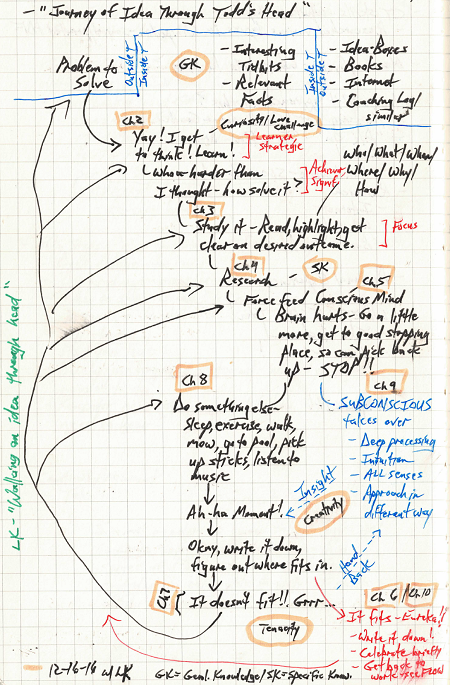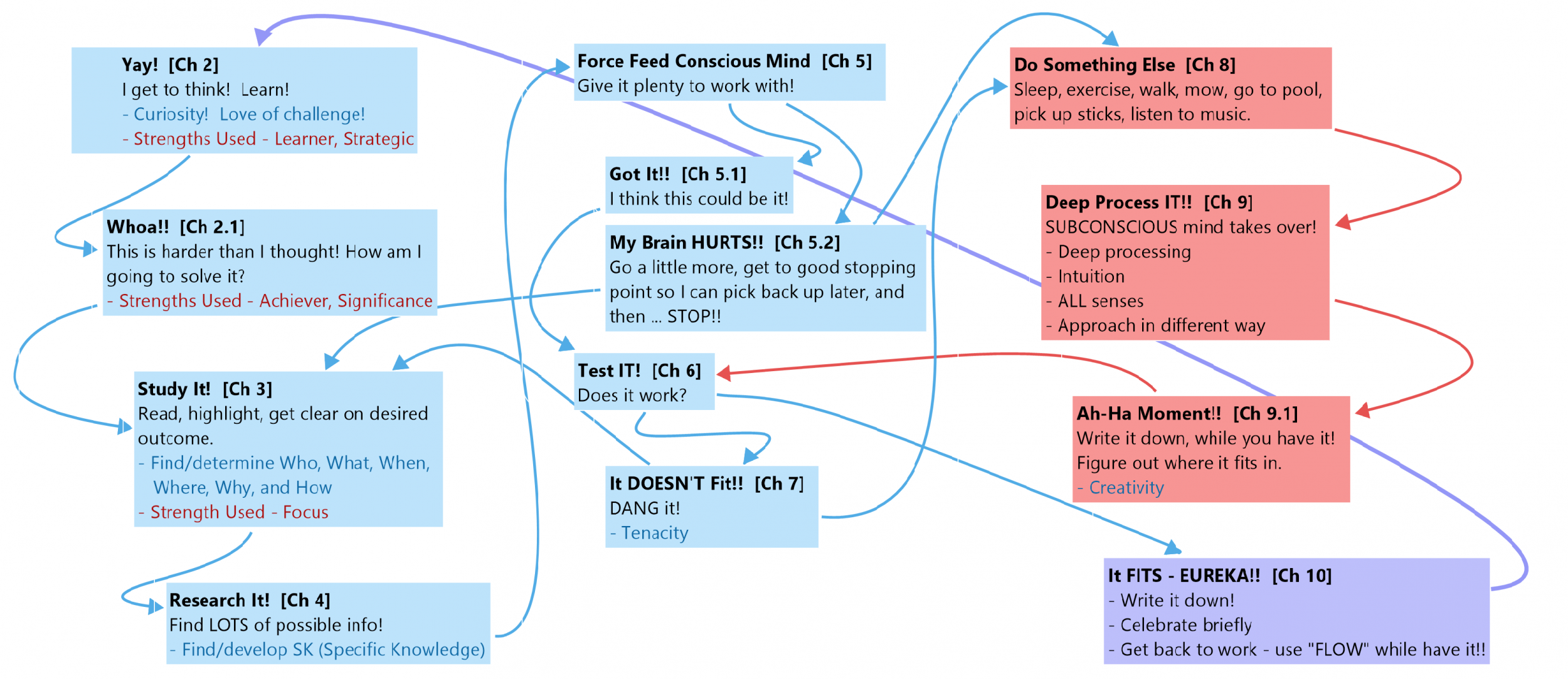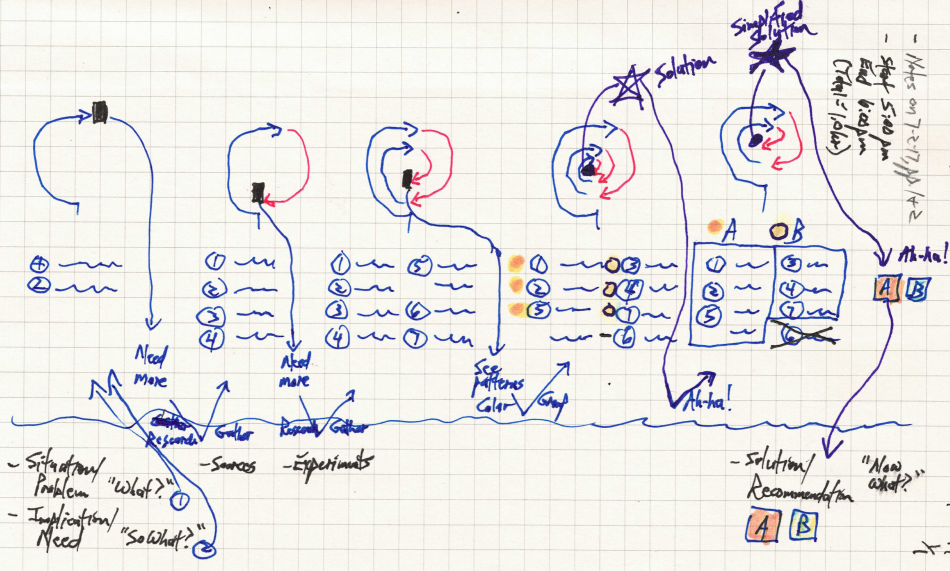How do you come up with new ideas?

My journey with “Thinking About Thinking” first began in the summer of 2016, when I told my Coach about my CRAZY idea of writing a book to help people think better. She was actually VERY excited about the concept, and even brought some notes to discuss when she treated me to a birthday lunch the following week! In fact, she suggested I keep track of how I go about thinking about my thinking. Wow, that is SO meta!
She helpfully suggested I consider calling this exercise “Journey of An Idea Through Todd's Head.”
Journey of an Idea Through Todd's Head
After lunch, I reflected on recent examples of how I took an idea from initial thought to final deliverable. The problem? Each journey was a different length – some final deliverables were easy to visualize and produce, while others took MANY iterations to get clear. A key insight – thinking can be frustrating, especially when it's not on the timetable we need to please our boss, client, spouse, significant other, or someone else.
So, late in the evening that same day I sat down and doodled about the start-and-stop nature of my thought process, including both the fun and frustration along the way. Here's what I drew – part doodle, part mind map, and part process flow:

The black, red, and blue lines and the writing all flowed out of me in about 30 minutes. Needless to say, I was “In The Zone.”
What about the green text, and the black text circled with orange highlighter? Those items came from a session with my Creative Coach later that same year.
A Cleaned Up “Journey”
I admit it, I have messy handwriting. So, here's a cleaned up version of my drawing:

A few comments:
- The Blue Rectangles represent steps when the CONSCIOUS mind is front and center.
- While this mind is typically associated with Critical Thinking, Creative Thinking can be coaxed to come out and play ... under the right circumstances.
- The Red Rectangles reflect steps when the SUBCONSCIOUS mind is active.
- You may not even realize you're doing Creative Thinking, because you're using your CONSCIOUS mind for something else like eating, walking, or exercising – nonetheless, your SUBCONSCIOUS mind does deep processing in the background.
- The Purple Rectangle reflects the most elusive step of all, the EUREKA! feeling when an Ah-Ha Moment! idea has been successfully tested and found to FIT your needs!
- In this step, the processing of the CONSCIOUS and SUBCONSCIOUS minds converge to produce an answer – woo hoo!
Occasionally, I'm lucky and an idea takes just a single journey through my head to emerge in fully-developed form. Most times, multiple journeys are required.
From “It FITS!” to “Solution and Recommendation”
A while later, I tried to depict – in doodle form – what was happening to an idea as it took multiple journeys through my mind. Here's what I came up with:

In this doodle:
- Critical Thinking – Blue ink
- Creative Thinking – Red ink
- Overlap of Critical and Creative Thinking – Purple ink
- Notes and Explanations – Black ink
An idea flows from left to right, and each column represents a different thinking session using the CONSCIOUS mind.
- From the starting point at the bottom of each labyrinth-like doodle, the idea develops going clockwise, potentially cycling several times between Critical Thinking and Creative Thinking, until finally hitting a constraint or “The Wall” reflected by the black rectangle at the labyrinth's center.
- Undeterred, the idea “jumps” out of the labyrinth and hangs around letting the SUBCONSCIOUS mind process in the background, until it is time for another thinking session – progress is made until it, too, hits a wall, so the newly-improved idea “jumps” out and waits for the next session.
- During the fourth thinking session, the idea has been sufficiently developed to allow Critical Thinking and Creative Thinking to form it into an Initial Solution, represented by the open purple star at the center of the fourth labyrinth.
- Finally, the fifth thinking session yields a more elegant Simplified Solution, represented by the colored-in purple star at the center of the final labyrinth.
At this point, the solution still exists in a visual or abstract form, and it will need to be preserved in some way – whether via doodle, words, or both.
As I think repeatedly about an idea, my idea generally ...
- Starts small, as Critical Thinking kicks off the process with a couple of input items [1,2],
- Begins to introduce Creative Thinking after I bring in a couple more items [3,4] to consider,
- Picks up in intensity and length as I add three new items [5,6,7] to ponder,
- Gets interesting when I use orange [1,2,5] and yellow [3,4,7] highlighters to color code the items and group “like with like” to come up with an Initial Solution, and
- Climaxes with developing thesis statements A and B (after dropping one item [6] that didn't fit anywhere) to correspond to the orange and yellow items, respectively, comprising the Simplified Solution!
Having insights and researching key topics, mixing those results in with the others, processing them with both Critical and Creative Thinking, grouping them, and pruning them – these are key building blocks I use to develop an idea.
Your Thoughts?
I'd be very interested in hearing your feedback on this particular e-newsletter, especially what you found helpful, where you'd like to go deeper into a topic, and how you go about coaxing out your best ideas. Who knows, there might end up being several follow-up e-newsletters – or even a book – coming out of this!
Sincerely,
![]()
Todd L. Herman
PS – Take a look at our latest video for tips on Sharpening Your Critical Thinking Skills!






